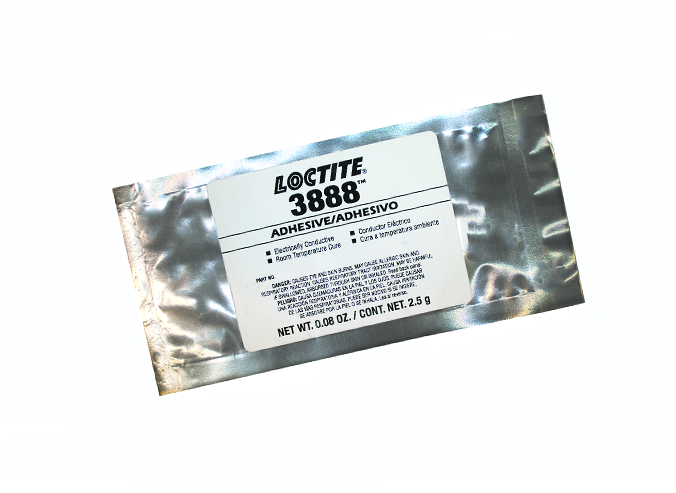LOCTITE ABLESTIK 3888
- Repair kit
- Two component silver epoxy
- Repair/Rework interconnections
Product Description
LOCTITE ABLESTIK 3888 is a two part epoxy paste, designed for bonding of metals, ceramics, rubbers and plastics as used in electronic parts, where good adhesion combined with electrical and thermal conductivity is required. It contains a resin and a hardener and can cure either in room temperature or with heat.
LOCTITE ABLESTIK 3888 has many practical applications which include and are not limited to solder replacement, repair/rework of interconnections, and bonding of heat sensitive components where solder temperatures are impractical. It can withstand operating temperatures up to 80°C.
Cure Schedule:
- 24 hours @ 23 °C
- 2 hours @ 65 °C
- 1 hour @ 125 °C
- 30 minutes @ 150 °C
Technical Specifications
| General Properties | |
| Pot Life Pot Life Pot life is the amount of time it takes for the viscosity of a material to double (or quadruple for lower viscosity materials) in room temperature after a material is mixed. It is closely related to work life but it is not application dependent, less precise and more of a general indication of how fast a system is going to cure. | 1.5 hours |
| Specific Gravity Specific Gravity Specific gravity (SG) is the ratio of the density of a substance to the density of a reference substance; equivalently, it is the ratio of the mass of a substance to the mass of a reference substance for the same given volume. For liquids, the reference substance is almost always water (1), while for gases, it is air (1.18) at room temperature. Specific gravity is unitless. | 2.5 |
| Thermal Properties | |
| Glass Transition Temperature (Tg) Glass Transition Temperature (Tg) The glass transition temperature for organic adhesives is a temperature region where the polymers change from glassy and brittle to soft and rubbery. Increasing the temperature further continues the softening process as the viscosity drops too. Temperatures between the glass transition temperature and below the decomposition point of the adhesive are the best region for bonding. The glass-transition temperature Tg of a material characterizes the range of temperatures over which this glass transition occurs. | 50 °C |
| Thermal Conductivity Thermal Conductivity Thermal conductivity describes the ability of a material to conduct heat. It is required by power packages in order to dissipate heat and maintain stable electrical performance. Thermal conductivity units are [W/(m K)] in the SI system and [Btu/(hr ft °F)] in the Imperial system. | 1.5 W/m.K |
| Electrical Properties | |
| Volume Resistivity Volume Resistivity Volume resistivity, also called volume resistance, bulk resistance or bulk resistivity is a thickness dependent measurement of the resistivity of a material perpendicular to the plane of the surface. | 1.0x10-4 Ohms⋅cm |
Additional Information
What is a Twinpak?
TwinPaks are part A and B in the same package, separated by a plastic bar. (think of it like what you do to seal half-eaten bags of potato chips). The bar (once removed) is then used to mix A and B together. Once they are mixed, the corner of the pack is cut and the "b-stage epoxy" is applied to the part.




